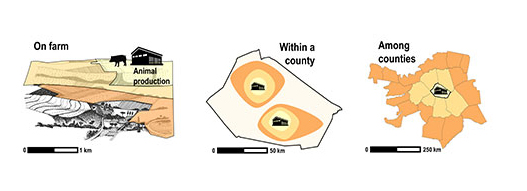
Features
Moving Manure: Redistributing surplus nutrients
“Manureshed” model connects crop and livestock production to recycle nutrients.
January 18, 2021 by Rebecca Hannam
 Maps detailing crop and livestock production, manure varieties and phosphorus levels (P), and P redistribution. Images courtesy of the USDA Long-Term Agroecosystem Research (LTAR) network.
Maps detailing crop and livestock production, manure varieties and phosphorus levels (P), and P redistribution. Images courtesy of the USDA Long-Term Agroecosystem Research (LTAR) network. Redistributing surplus manure nutrients to ensure sustainable agricultural production is the goal of ongoing research led by USDA Agricultural Research Service (ARS) scientists. Researchers have created a conceptual framework to link livestock operations with excess manure to nutrient-deficient croplands as a solution to managing concentrated manure accumulations.
Rangeland management specialist Sheri Spiegal says animal agriculture has become separated from crop farming over time and concentration has increased in specific areas. “Now we have accumulations of manure in concentrated places with no widespread, cost-effective mechanisms to get the nutrients back into cropland for further crop production.”
Among the challenges related to long-term manure accumulation are water and air quality. Lack of manure movement also contributes to patterns of commercial fertilizer use, which in turn has raised concerns about long-term food supply and environmental health.
Developing vision
In a paper published in Agricultural Systems in June 2020, Spiegal and her ARS colleagues proposed a framework to address these challenges – reconnecting animal and plant agriculture through “manuresheds.” Similar in concept to watersheds, a manureshed is defined as the land around animal feeding operations onto which manure nutrients can be redistributed to meet environmental, production and economic goals.
According to the paper, manuresheds can be managed at multiple scales – on a farm with both animals and crops, among animal farms and crop farms within a county or among farms across county or even state or provincial lines.
While the concept is not completely new – redistributing manure for crop production is currently a management practice used within individual farming operations as well as through agreements between animal and crop farmers – Spiegal says the vision is to develop communal or co-operative structures that are sustainable and cost-effective.
Initial analysis
To introduce the manureshed framework, researchers used the Nutrient Use Geographic Information System (NuGIS) and the 2012 United States Census of Agriculture to classify each U.S. county as a manure nutrient “source” or “sink”.
This classification was completed using data on manure produced by confined livestock as opposed to manure from grazing lands due to relative ease of manure collection. From a nutrient perspective, this study quantified phosphorus (P) and nitrogen (N) because of their roles as major fertilizer ingredients.
The results of this analysis enabled researchers to describe four conceptual manuresheds across the U.S., representing the major livestock sectors of poultry, swine, dairy and beef. The Puget Sound Dairy and Poultry, Southern Plains Beef and Dairy, Interior Highlands Poultry and Carolina Poultry and Hog manuresheds are detailed by characteristics of source and sink counties and the average minimum transport distances between them.

The manureshed model looks to redistribute manure to nearby cropland where the nutrients are needed.
Long-term plans
Now that the initial paper has been published, Spiegal and her colleagues are producing a special issue in the Journal of Environmental Quality. A virtual symposium will also be held at the 2020 American Society of Agronomy, Crop Science Society of America and Soil Science Society of America annual meeting.
Over the next 10 years, manureshed research will expand in many directions. “We are going to be looking at the different constraints and opportunities for manure redistribution in each animal sector as well as technologies for solid-separation,” Spiegal says, noting that separation is key to dairy and swine manure redistribution.
Researchers will be working with producer partners to conduct long-term field research on the economic and environmental costs and benefits of importing manure nutrients to cropland and grazing land in different climates.
Beyond traditional land management and technology research, Spiegal and her colleagues will also be working to build societal awareness of the benefits and challenges of the manureshed approach and determine what is needed for widespread support of the concept.
“In addition, there is a plan for economic research on the cost effectiveness of different types of management practices, as well as the need for economic incentives,” she says.
Diverse collaboration
The researchers behind this initiative belong to the USDA Long-Term Agroecosystem Research (LTAR) network – a group focused on strategies for the sustainable intensification of agriculture. The network is a partnership between 18 research sites across the U.S., which has recently expanded to include Canadian researchers through Agriculture and Agri-Food Canada (AAFC) and the Living Laboratories Initiative.
Spiegal started working with other range ecologists and crop and soil scientists on the manureshed concept in 2018, but the group has now expanded into what she calls a vibrant team that includes social scientists and agricultural economists. She says the diversity in expertise is important because their topic targets a wide range of audiences, including producers, industry groups, policymakers, residents living near livestock operations and even urban dwellers who are interested in food production.